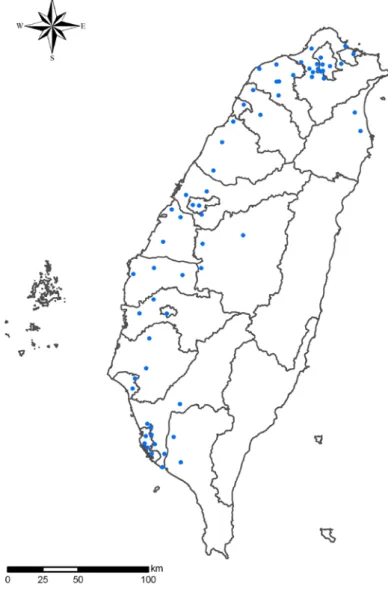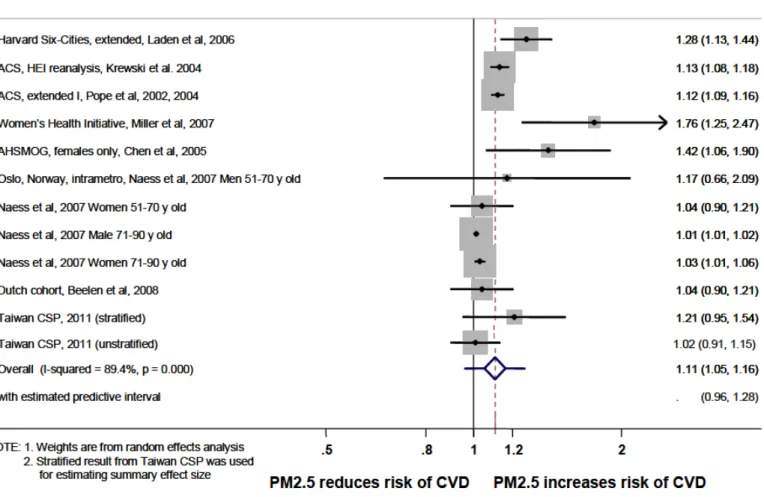HEALTH ASSESSMENT OF FINE PARTICLE ON CARDIOVASCULAR DISEASE MORBIDITY AND MORTALITY
Wen-Chao Ho1*, Meng-Hung Lin1, Hsien-Ho Lin2, Pau-Chung Chen3*, Tsun-Jen Cheng3
1Department of Public Health, China Medical University, Taichung, Taiwan,
2Institute of Epidemiology and Preventive Medicine National Taiwan University, Taipei, Taiwan, 3Institute of Occupational Medicine and Industrial Hygiene, National Taiwan University, Taipei,
Taiwan.
*Corresponding Author, Tel: +886 4 2205 3366*6117, Fax: +886 4 2201 9901, E-mail: whocmu@gmail.com
ABSTRACT
In recent years, Taiwan EPA air quality monitoring station data show that there is
an improving trend in air quality, but the particles (particular matter, PM)
concentration compared with the standard value is still high. The impact of fine
suspended particles (PM2.5) on the environment and human health are more widely
concerned recently, especially in developed countries. The National Morbidity
Mortality Air Pollution Study, NMMAPS, in USA pointed out that the fine suspended
particles PM2.5 had health impact on mortality more than suspended particles PM10.
Harvard Six Cities Study also showed that the fine suspended particles PM2.5 could
increase the cardiovascular and respiratory diseases mortality. Furthermore, the
component composition of fine suspended particulate and its interaction with ozone
may have significant effects related to respiratory and cardiovascular disease
mortality
1-9. Although the health effects of suspended particles have been studied in
Taiwan
10-17, fine suspended particulate (PM2.5) is not well assessed. Nevertheless,
PM2.5 may also interact with traffic pollutants and ozone and cause further harm to
health.
INTRODUCTION
There is highly traffic density in Taiwan. In the meantime, the ozone episode day
also continues to increase. The issues of fine suspended particulate (PM2.5) on health
hazards, especially for respiratory and cardiovascular, have recently been raised.
Four main databases were assessed in this study. They were: 1) air pollution data,
hourly air pollution data collected by using air monitoring stations from Taiwan EPA
during 2000-2009 (with modeling estimation for PM2.5 during 2000-2005), 2) death
registration database, study population collected from death registry system in Taiwan
during 2000-2009, 3) National Health Insurance Registry database during 2000-2009,
both mortality and morbidity study areas were the townships having air quality
stations (Figure 1), total 64 townships included, and 4) cancer screening cohort. Both
long term and short term effects were assessed based on annual diseases morbidity
and mortality analyses, survival analyses and case-crossover design analyses.
Repeated-Poisson regression, Cox-proportional hazard model and conditional logistic
regression were used. Controlling risk factors included: sex, age, degree of
urbanization, density of cardiology physicians, temperature, and humidity. Personal
risk factors were further assessed in the cohort study.
The daily and annual average (medium and Inter-quartile Range, IQR) of PM2.5
was 34.61ug/m3 (30.05ug/m3 and 27.21ug/m3) and 35.97ug/m3 (34.69ug/m3 and
13.74ug/m3), respectively (Table 1). Based on the morbidity and mortality analyses,
the air quality standard for PM2.5 to be lower than 32.15ug/m3 and 27.8ug/m3 for
short term (daily) and long term (annual) exposure was suggested (Figures 2-3).
Cancer screening cohort study showed the comparable and similar results with
previous findings from other cohort studies (Figure 4). To summarize the findings of
this study, there were: 1) it showed more potential significant results of PM2.5 related
to health effects in urban cities, especially Taipei, 2) there were some city-specific
seasonal diseases that should be considered, for example: Taichung and Kaohsiung,
and 3) the results of long-term and short-term showed highly comparable. Further
research was in need and suggested.
Acknowledgments
This study was supported by grant NSC 99-EPA-M-001-001 from the Environmental Protection Administration in Taiwan.
REFERENCES
1. Villeneuve PJ, Goldberg MS, Krewski D, Burnett RT, Chen Y. 2002. Fine particulate air pollution and all-cause mortality within the Harvard Six-Cities Study: variations in risk by period of exposure. Ann Epidemiol 12(8): 568-576.
2. Dockery DW, Pope CA, 3rd, Xu X, Spengler JD, Ware JH, Fay ME, et al. 1993. An association between air pollution and mortality in six U.S. cities. N Engl J Med 329(24): 1753-1759.
3. Pope CA, 3rd, Thun MJ, Namboodiri MM, Dockery DW, Evans JS, Speizer FE, et al. 1995. Particulate air pollution as a predictor of mortality in a prospective study of U.S. adults. Am J Respir Crit Care Med 151(3 Pt 1): 669-674.
4. Pope CA, 3rd, Burnett RT, Thun MJ, Calle EE, Krewski D, Ito K, et al. 2002. Lung cancer,
cardiopulmonary mortality, and long-term exposure to fine particulate air pollution. JAMA : the journal of the American Medical Association 287(9): 1132-1141.
5. Pope CA, 3rd, Muhlestein JB, May HT, Renlund DG, Anderson JL, Horne BD. 2006. Ischemic heart disease events triggered by short-term exposure to fine particulate air pollution. Circulation 114(23):
2443-2448.
6. Brook RD, Rajagopalan S, Pope CA, 3rd, Brook JR, Bhatnagar A, Diez-Roux AV, et al. 2010. Particulate matter air pollution and cardiovascular disease: An update to the scientific statement from the American Heart Association. Circulation 121(21): 2331-2378.
7. Puett RC, Schwartz J, Hart JE, Yanosky JD, Speizer FE, Suh H, et al. 2008. Chronic particulate exposure, mortality, and coronary heart disease in the nurses' health study. Am J Epidemiol 168(10): 1161-1168.
8. Laden F, Schwartz J, Speizer FE, Dockery DW. 2006. Reduction in fine particulate air pollution and mortality: Extended follow-up of the Harvard Six Cities study. Am J Respir Crit Care Med 173(6): 667-672.
9. Yorifuji T, Kashima S, Tsuda T, Takao S, Suzuki E, Doi H, et al. 2010. Long-term exposure to traffic-related air pollution and mortality in Shizuoka, Japan. Occupational and environmental medicine 67(2): 111-117.
10. Hsieh YL, Yang YH, Wu TN, Yang CY. 2010. Air pollution and hospital admissions for myocardial infarction in a subtropical city: Taipei, Taiwan. J Toxicol Environ Health A 73(11): 757-765.
11. Tsai SS, Chiu HF, Wu TN, Yang CY. 2009. Air pollution and emergency room visits for cardiac arrhythmia in a subtropical city: Taipei, Taiwan. Inhalation toxicology 21(13): 1113-1118.
12. Bell ML, Levy JK, Lin Z. 2008. The effect of sandstorms and air pollution on cause-specific hospital admissions in Taipei, Taiwan. Occupational and environmental medicine 65(2): 104-111. 13. Chan CC, Chuang KJ, Chien LC, Chen WJ, Chang WT. 2006. Urban air pollution and emergency admissions for cerebrovascular diseases in Taipei, Taiwan. European heart journal 27(10): 1238-1244. 14. Lee IM, Tsai SS, Ho CK, Chiu HF, Yang CY. 2007. Air pollution and hospital admissions for congestive heart failure in a tropical city: Kaohsiung, Taiwan. Inhalation toxicology 19(10): 899-904. 15. Tsai SS, Goggins WB, Chiu HF, Yang CY. 2003. Evidence for an association between air pollution and daily stroke admissions in Kaohsiung, Taiwan. Stroke; a journal of cerebral circulation 34(11): 2612-2616.
16. Yang CY, Chang CC, Chuang HY, Tsai SS, Wu TN, Ho CK. 2004. Relationship between air pollution and daily mortality in a subtropical city: Taipei, Taiwan. Environment international 30(4): 519-523.
17. Wang CH, Chen CJ, Lee MH, Yang HI, Hsiao CK. 2010. Chronic hepatitis B infection and risk of atherosclerosis-related mortality: A 17-year follow-up study based on 22,472 residents in Taiwan. Atherosclerosis 211(2): 624-629.
Figure2. Adjusted RR* for disease specific emergency department(ED) visits (I), Hospital Admission (II), and Mortality (III) in two-pollutant model† using Poisson regression in Taiwan (including Taipei, Taichung, and Kaohsiung), 2006-2009.
Figure 3. Percent increase in risk and 95% CI of disease specific emergency department (ED) visits (I), Hospital Admission (II), and Mortality (III) associated with annual average PM2.5 stratified by various season (A: all season, B: warm season and C: cool season), 2000-2009.


